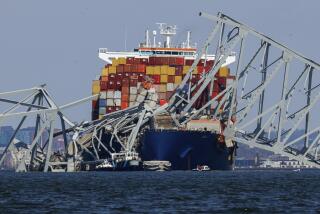Longer drives over new routes
- Share via
MINNEAPOLIS — Commuting from his downtown job at the Hennepin County Medical Center to his suburban home used to take Oge Alozie about 10 minutes. Now, it is often closer to 45.
Like tens of thousands of others, the internal medicine intern crossed the Interstate 35W bridge twice a day before it collapsed one month ago.
With the bridge gone, Alozie said life was more stressful as he experiments with side-street routes to get him to his daughter’s day care on time in the evening. He also has a nagging feeling when he crosses bridges.
“There is trauma,” he said. “At the back of your mind, it’s just there.” As the Twin Cities move from mourning the loss of 13 lives in the Aug. 1 catastrophe to trying to return to normalcy, residents are just coming to terms with the realities of daily life without a bridge that was the second-busiest in Minnesota.
Patience will be further tested Tuesday when the fall semester begins at the University of Minnesota, bringing an influx of thousands to the congested area.
With portions of the bridge still blocking Mississippi River barge traffic, the collapse investigation remains in its infancy.
Even if the planned rapid construction schedule is successful, a new bridge -- at an estimated cost of at least $250 million -- will not be in place until late next year at the earliest, well after the Twin Cities host the 2008 Republican National Convention.
Already, there are signs of potential delays. Last week, one of the nation’s largest general contractors said it no longer wanted to be part of the project.
Still, some positive news arrived with the re-opening of a nearby bridge closed since the collapse. The reconfigured 10th Avenue bridge opened Friday, with two lanes of vehicle traffic -- down from four -- and a walkway for viewing the collapse site.
Almost immediately, it was filled with hundreds of curiosity seekers, most toting cameras, getting a previously unavailable close-up view .
“It’s hard to believe all that stuff could just collapse like that,” said Staci Gallahue, as she snapped photos from the vantage point.
“On TV, it was hard to get a sense of how far cars actually fell. It’s still hard to imagine.” Kent Barnard, a spokesman for the Minnesota Department of Transportation, said officials did not yet have hard data on how much commutes had grown.
By repaving shoulders, extra lanes have been added on some nearby highways. “We’re trying to squeeze out some extra capacity,” Barnard said.
While long commutes are common in larger cities, many in the Twin Cities, the nation’s 16th-largest metropolitan area, consider short commutes and other quality-of-life benefits as a fair exchange for brutal winters.
Before the bridge fell, it carried about 140,000 vehicles a day. “That bridge was a major arterial to campus, so it has created some huge congestion issues,” said Dan Wolter, a University of Minnesota spokesman.
More to Read
Sign up for Essential California
The most important California stories and recommendations in your inbox every morning.
You may occasionally receive promotional content from the Los Angeles Times.













